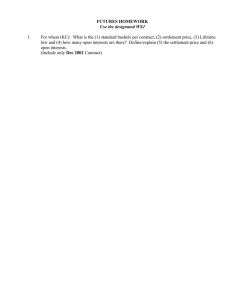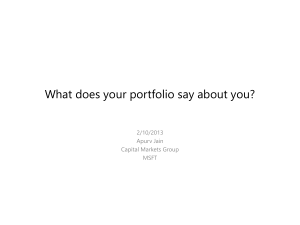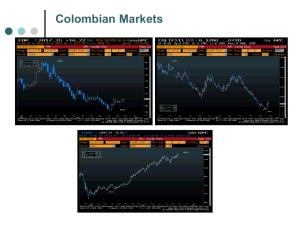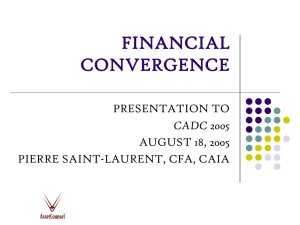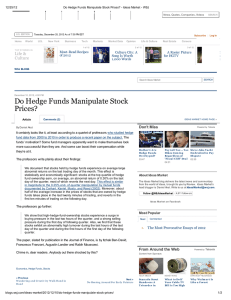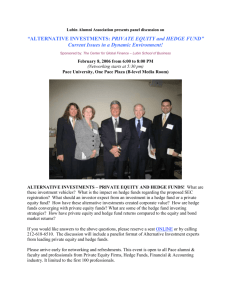Investment Analysis, John King, CFA, Cleveland State Univ
advertisement
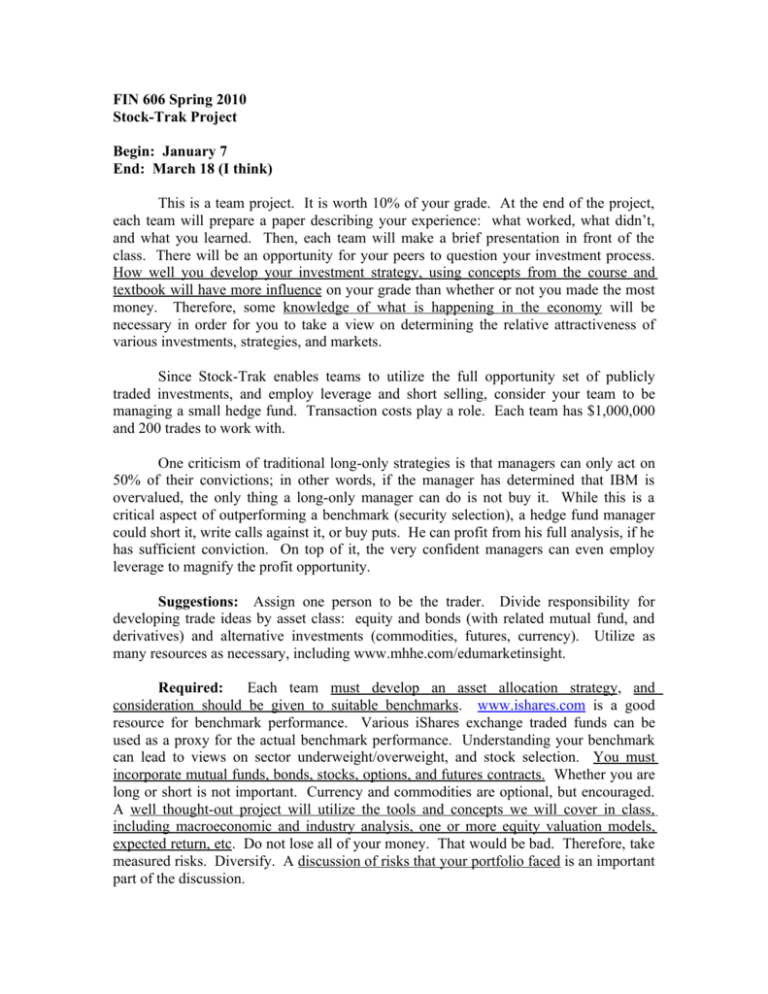
FIN 606 Spring 2010 Stock-Trak Project Begin: January 7 End: March 18 (I think) This is a team project. It is worth 10% of your grade. At the end of the project, each team will prepare a paper describing your experience: what worked, what didn’t, and what you learned. Then, each team will make a brief presentation in front of the class. There will be an opportunity for your peers to question your investment process. How well you develop your investment strategy, using concepts from the course and textbook will have more influence on your grade than whether or not you made the most money. Therefore, some knowledge of what is happening in the economy will be necessary in order for you to take a view on determining the relative attractiveness of various investments, strategies, and markets. Since Stock-Trak enables teams to utilize the full opportunity set of publicly traded investments, and employ leverage and short selling, consider your team to be managing a small hedge fund. Transaction costs play a role. Each team has $1,000,000 and 200 trades to work with. One criticism of traditional long-only strategies is that managers can only act on 50% of their convictions; in other words, if the manager has determined that IBM is overvalued, the only thing a long-only manager can do is not buy it. While this is a critical aspect of outperforming a benchmark (security selection), a hedge fund manager could short it, write calls against it, or buy puts. He can profit from his full analysis, if he has sufficient conviction. On top of it, the very confident managers can even employ leverage to magnify the profit opportunity. Suggestions: Assign one person to be the trader. Divide responsibility for developing trade ideas by asset class: equity and bonds (with related mutual fund, and derivatives) and alternative investments (commodities, futures, currency). Utilize as many resources as necessary, including www.mhhe.com/edumarketinsight. Required: Each team must develop an asset allocation strategy, and consideration should be given to suitable benchmarks. www.ishares.com is a good resource for benchmark performance. Various iShares exchange traded funds can be used as a proxy for the actual benchmark performance. Understanding your benchmark can lead to views on sector underweight/overweight, and stock selection. You must incorporate mutual funds, bonds, stocks, options, and futures contracts. Whether you are long or short is not important. Currency and commodities are optional, but encouraged. A well thought-out project will utilize the tools and concepts we will cover in class, including macroeconomic and industry analysis, one or more equity valuation models, expected return, etc. Do not lose all of your money. That would be bad. Therefore, take measured risks. Diversify. A discussion of risks that your portfolio faced is an important part of the discussion. Some ideas to help guide your thought process: 1. Develop an asset allocation. Given where we are in the business cycle, would you be under or overweight bonds? What will be your allocation to domestic equity, domestic small cap equities, and international developed and emerging markets equities? 2. Will emerging markets stocks exhibit more correlation with the US market this year? 3. Invest for a diversified portfolio, instead of a series of trades with no rhyme or reason 4. What projections do you have for the world economy? Will the current commodity cycle continue its rate of growth? 5. What is your view on the dollar? What factors could see a long position begin to rally relative to other currencies? 6. Do you have an overall investment theme? 7. What impact will interest rate cuts have on the economy, and the broader markets? 8. What is your view on inflation? Are there any plays to be made in interest rate futures, TIPS, etc.? What investments are benefiting from low or high inflation 9. What sectors would benefit from lower interest rates? Which would suffer from higher interest rates? 10. How will you identify undervalued stocks? What financial ratios will you use to screen stocks? Consider using relative valuation and discounted cash flow valuation models. Are you looking for growth oriented companies with superior earnings growth? 11. How will emerging legislation (financial markets reform, health care reform, government fiscal stimulus programs) affect your view of market, sector, security performance going forward? 12. What stocks appear overvalued to you today? Why? What stocks appear cheap? What measure are you using to evaluate value? 13. What is the forecast for corporate earnings? Are consensus estimates too high? Would this lead you to short those stocks where expectations are high? 14. What is your best estimate on the future course of interest rate spreads-widening or narrowing? Would you be favoring long duration or short duration bonds right now? Do you forecast higher default rates by corporate issuers? 15. What is your sell discipline? Since we will consider ourselves to be managing a Hedge Fund, what is a Hedge Fund? Due to the fact that they are commonly structured as private partnerships, and thus subject to only minimal SEC regulation, managers can pursue various strategies and employ heavy use of derivatives, leverage, and short sales, that are unavailable to the mutual fund manager. I. II. Hedge Funds Category Definitions (TASS Research: Source: Dynamics of the Hedge Fund Industry (Andrew W. Lo, 2005) Research Foundation of CFA Institute. a. Types i. Equity Hedge: a directional strategy involving equity oriented investing on both the long and short sides of the market. Objective is not to be market neutral. Managers can shift equity style from value to growth, move up or down market capitalization from small to medium to large caps, and/or go from a net long position to a net short position. Managers may use futures and options to hedge. Portfolios tend to be more concentrated, especially if focusing on a sector or region ii. Non-directional/relative value: designed to exploit equity and or fixed income market inefficiencies and usually involves being simultaneously long and short matched market portfolios of the same size within a country. Designed to be either beta or currency neutral or both iii. Convertible arbitrage: Managers for instance could be long the convertible bond, and short the common stock of the same company. Profits are earned on the bond; as well as the short sale of the stock iv. Event Driven: Investing to capture price movement generated by a significant pending corporate event, such as a merger, corporate restructuring, liquidation, bankruptcy, or reorganization. 1. Risk (merger) arbitrage 2. Distressed (high yield) securities v. Global Macro: carry long and short positions in any of the world’s major capital or derivative markets. Positions reflect views on overall market direction as influenced by major economic trends or events. The portfolio could include stocks, bonds, currencies, and commodities in the form of cash or derivatives. Most funds invest globally in both developed and emerging markets. vi. Multi-strategy: employ combination of the above vii. Fund of funds: fund manager selects other hedge fund managers to achieve diversification benefits, access to funds Fees a. Hedge funds have two explicit fees: the management fee and the incentive fee. You can choose your own fee structure, with management fees of between 1-2% and incentive fees of between 2 and 25%. You can choose to have a hurdle rate: if you don’t beat your absolute return target, or your suitable benchmark, the incentive fee will not apply. As a guide, some common hurdle rates are T-bills return, S&P 500 return , or an absolute return of say, 7%. We will compare the after fee performance of each team-both from an investor’s perspective and the manager’s perspective!
